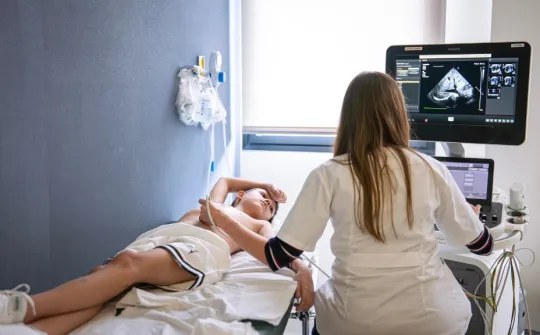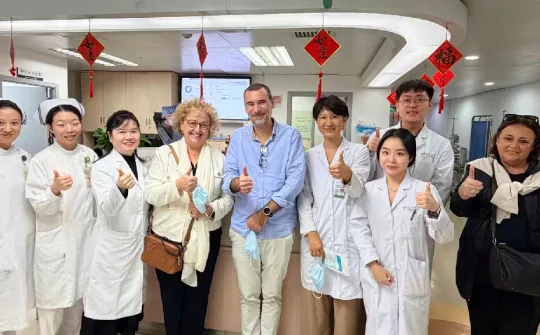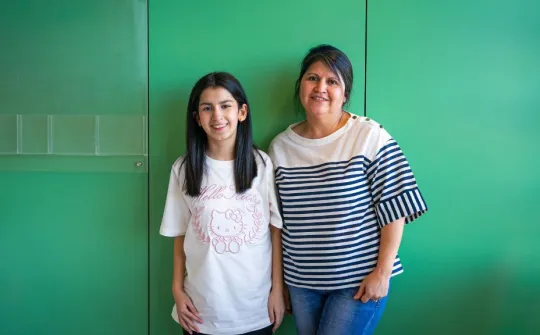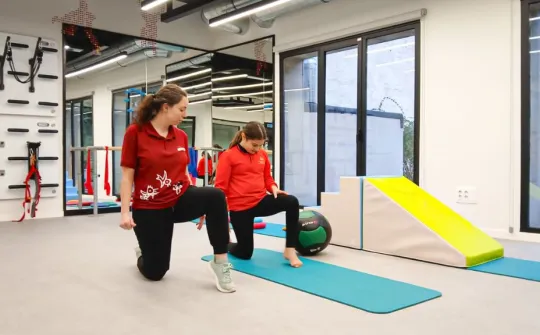
Youssef and his family travelled from Morocco to Barcelona for a bone marrow transplant to cure the child’s aplastic anemia.
One day, when Youssef was 10 years old, he found bruises on his legs and small petechiae. His parents took him to a hospital in Morocco, where he had a blood test done. The results showed his platelet count was very low. Hospital staff then performed a bone marrow aspiration and prescribed corticosteroid and immunoglobulin treatment.
After the second bone marrow aspiration, specialists saw that his platelet count was not improving, and, after an appointment at another hospital's Hematology Department, he was diagnosed with aplastic anemia, a rare and very severe disease in which the bone marrow does not produce enough blood cells (red cells, white cells and platelets). To treat this disease, Youssef needed a bone marrow transplant.
His first option for the transplant would ideally have been a bone marrow from an HLA-identical sibling. Unfortunately, his sisters were not compatible. As there is no donor registry in his home country, hospitals can only perform transplants using bone marrow from family members. That meant that the family had to begin searching abroad (the United States, France, Switzerland, etc.) for an eligible anonymous donor.
One of Youssef’s family members, working as a biologist in their city, recommended the SJD Barcelona Children's Hospital to the family. ‘They have excellent hematologists,’ he told them.
The SJD Barcelona Children's Hospital performs around 30 allogenic transplants each year, has a separate isolation unit away from other patient rooms, and boasts JACIE international accreditation (Joint Accreditation Committee of the ISCT and European Group for Blood and Marrow Transplantation).
The family contacted the hospital and received a speedy response. In August 2021, Youssef and his family travelled to Barcelona, accompanied by a doctor. They went directly to the SJD Barcelona Children's Hospital, where the boy was admitted to the Hematopoietic Stem Cell Transplant Unit for two weeks. Then, he periodically returned to the hospital for treatment prior to the transplant procedure.
Dr Maria Trabazo del Castillo, pediatric hematologist, notes that ‘before a transplant from an unrelated donor, the patient has to be studied to see if they have any rejection antibodies specific to the donor cells, and if so, treatment must be administered to eliminate these antibodies. In Youssef’s case, we quickly found a suitable donor, but before being able to carry out the transplant, we had to perform desensitisation treatment to eliminate the incompatible antibodies. Then he could safely receive the transplant.’
Two months later, the process to carry out the bone marrow transplant began. It was a very difficult time for Youssef, who recalls that ‘it was really hard because so many things were happening to me in a short space of time. I had to shave my head, I got chemotherapy and a plasma treatment…’
Youssef was hospitalised in the HSCT room for 67 days
He admits, ‘when I think about it now, I feel nostalgic, like I want to go back. It doesn't really make sense, but it’s somewhere I felt safe.’ However, he adds that it was difficult because ‘in all that time, I could only see nurses and my parents, and I was really depressed.’
Youssef thinks fondly of his relationship with his nurses, and all the small gestures they did for him. ‘Every morning, one of the nurses would draw me a picture and hang it on the wall. At the end of the 67 days, I had tons of drawings.’
Youssef’s mother Leila remembers that ‘he got out of the transplant room on his birthday’.
Now, Youssef has made a full recovery and lives in Barcelona with his family. He is happy to live here and lead a normal life. He goes to school every day, has lots of friends, and he has also learned how to speak Spanish, Catalan, and English perfectly.
Now he comes to the hospital every month and a half for check-ups. Youssef adds that the hospital is like a second home, as he has been coming here for four years now. Youssef would like to become a volunteer at the hospital to help other children who are going through something similar. He says that he would cheer them on and give them hope: ‘If I did it, you can do it, too!’




